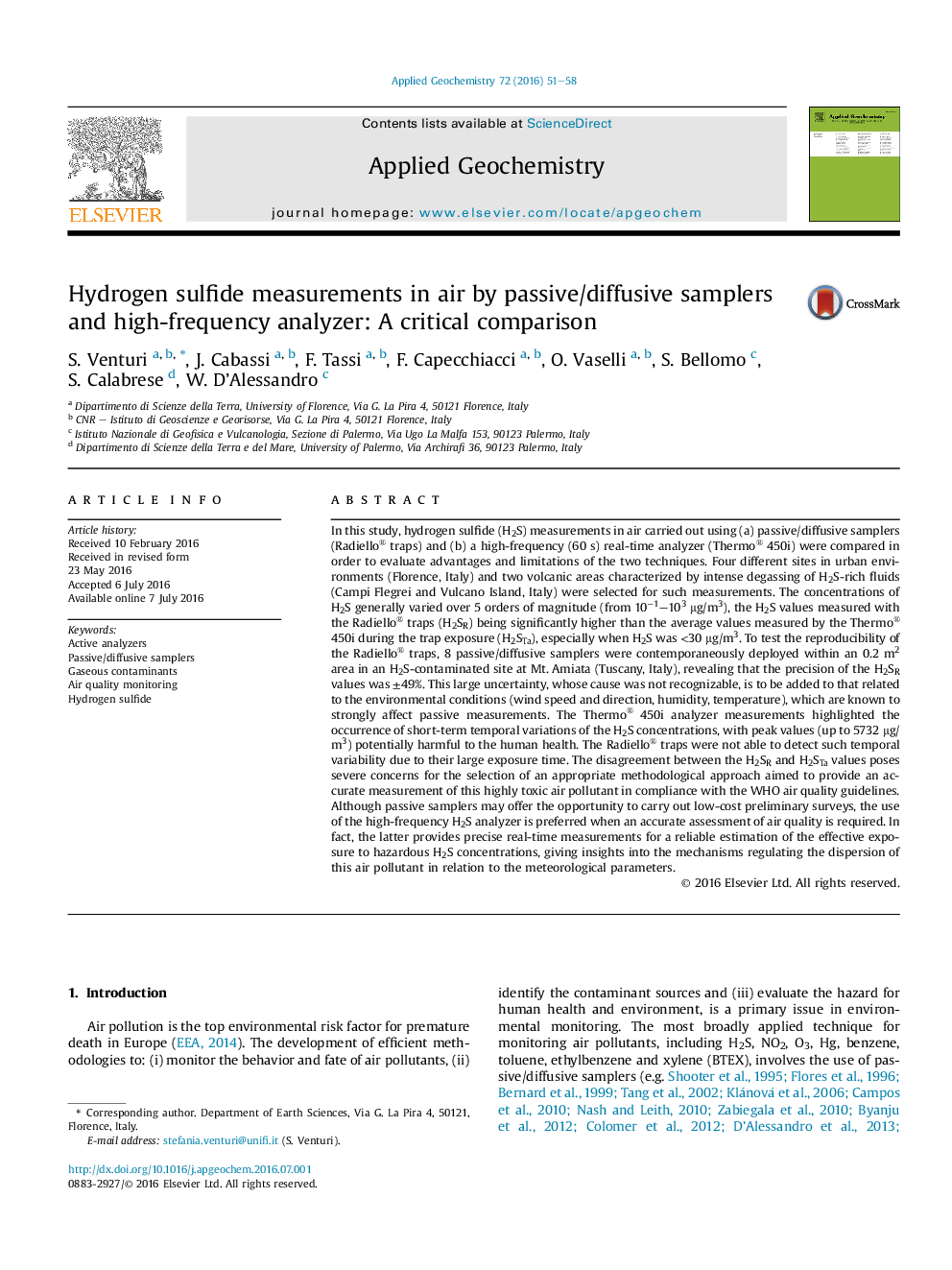| کد مقاله | کد نشریه | سال انتشار | مقاله انگلیسی | نسخه تمام متن |
|---|---|---|---|---|
| 6334802 | 1620219 | 2016 | 8 صفحه PDF | دانلود رایگان |
عنوان انگلیسی مقاله ISI
Hydrogen sulfide measurements in air by passive/diffusive samplers and high-frequency analyzer: A critical comparison
ترجمه فارسی عنوان
اندازه گیری های سولفید هیدروژن در هوا توسط نمونه گیرهای غیرفعال / پخش کننده و تحلیلگر فرکانس بالا: مقیاس بحرانی
دانلود مقاله + سفارش ترجمه
دانلود مقاله ISI انگلیسی
رایگان برای ایرانیان
کلمات کلیدی
آنالایزر فعال، نمونه گیرهای منفعل / انتشار آلاینده های گازی، نظارت بر کیفیت هوا، سولفید هیدروژن،
موضوعات مرتبط
مهندسی و علوم پایه
علوم زمین و سیارات
ژئوشیمی و پترولوژی
چکیده انگلیسی
In this study, hydrogen sulfide (H2S) measurements in air carried out using (a) passive/diffusive samplers (Radiello® traps) and (b) a high-frequency (60 s) real-time analyzer (Thermo® 450i) were compared in order to evaluate advantages and limitations of the two techniques. Four different sites in urban environments (Florence, Italy) and two volcanic areas characterized by intense degassing of H2S-rich fluids (Campi Flegrei and Vulcano Island, Italy) were selected for such measurements. The concentrations of H2S generally varied over 5 orders of magnitude (from 10â1-103 μg/m3), the H2S values measured with the Radiello® traps (H2SR) being significantly higher than the average values measured by the Thermo® 450i during the trap exposure (H2STa), especially when H2S was <30 μg/m3. To test the reproducibility of the Radiello® traps, 8 passive/diffusive samplers were contemporaneously deployed within an 0.2 m2 area in an H2S-contaminated site at Mt. Amiata (Tuscany, Italy), revealing that the precision of the H2SR values was ±49%. This large uncertainty, whose cause was not recognizable, is to be added to that related to the environmental conditions (wind speed and direction, humidity, temperature), which are known to strongly affect passive measurements. The Thermo® 450i analyzer measurements highlighted the occurrence of short-term temporal variations of the H2S concentrations, with peak values (up to 5732 μg/m3) potentially harmful to the human health. The Radiello® traps were not able to detect such temporal variability due to their large exposure time. The disagreement between the H2SR and H2STa values poses severe concerns for the selection of an appropriate methodological approach aimed to provide an accurate measurement of this highly toxic air pollutant in compliance with the WHO air quality guidelines. Although passive samplers may offer the opportunity to carry out low-cost preliminary surveys, the use of the high-frequency H2S analyzer is preferred when an accurate assessment of air quality is required. In fact, the latter provides precise real-time measurements for a reliable estimation of the effective exposure to hazardous H2S concentrations, giving insights into the mechanisms regulating the dispersion of this air pollutant in relation to the meteorological parameters.
ناشر
Database: Elsevier - ScienceDirect (ساینس دایرکت)
Journal: Applied Geochemistry - Volume 72, September 2016, Pages 51-58
Journal: Applied Geochemistry - Volume 72, September 2016, Pages 51-58
نویسندگان
S. Venturi, J. Cabassi, F. Tassi, F. Capecchiacci, O. Vaselli, S. Bellomo, S. Calabrese, W. D'Alessandro,
